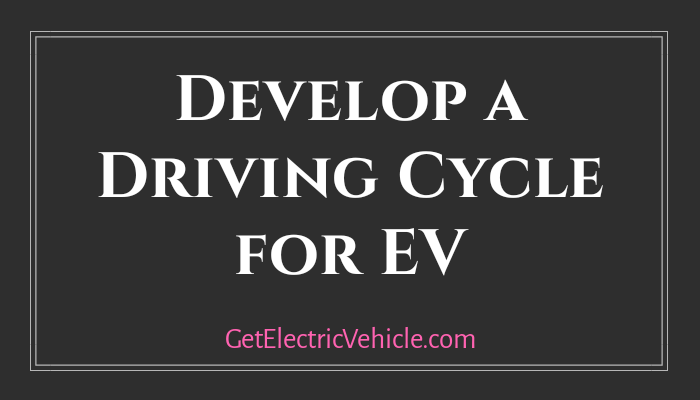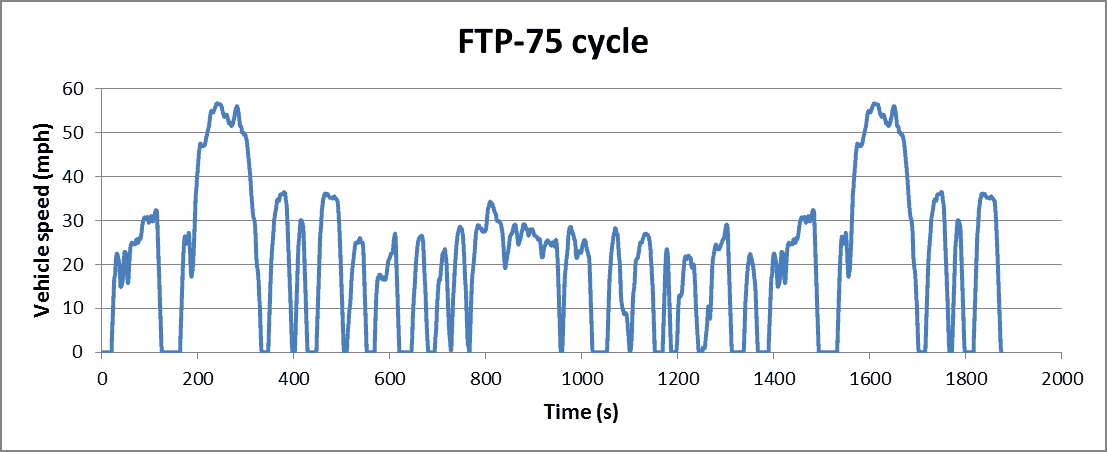
A driving cycle is a set of values, generally, velocity vs time, which represents how a vehicle travels through a path. In simple words, it would be a velocity vs time graph of a vehicle.
Why do we need a driving cycle?
Main uses of driving cycles are
- To assess the performance of a vehicle (fuel economy, emission tests)
- To analyze battery state and energy consumption in Electric Vehicles
- To simulate vehicle model prior to the actual development
Vehicles are designed and developed selecting components optimally. If an electric vehicle is considered, selection of motor, power electronics components, battery, mechanical parts involves calculation and optimization to reduce the losses in terms of energy and cost.
Different types of motors are used in an EV. The selection of motors also depends on many factors.
A vehicle model is simulated in simulation software to obtain the performance prior to actual development. In electric vehicle energy that stored in the battery of EV is transferred to the wheels through a converter, motor, and differential gears.
Every component in an electric vehicle is mathematically modeled in software (eg. Matlab). Energy consumption, battery performance, etc. are analyzed by simulating the model.
Two types of models are generally used for vehicle propulsion simulation. They are Backward facing model and Forward facing model.
The backward facing simulation calculates energy consumption at each stage of vehicle assuming the drive path of the vehicle is known.
That is the driving cycle will be applied at the tires of the vehicle model and the simulation back calculates the energy at each stage such as shaft, motor, inverter, and battery.
Types of Driving Cycles
Driving cycles can be classified as Model Driving Cycles and Transient Driving Cycles.
Model Driving Cycle
The model driving cycle comprises constant speed and does not represent a real driving pattern of a vehicle. These driving cycles will be used for specific applications such as an emission test.
New European Driving Cycle (NEDC) is an example of Model Driving Cycle.

Total distance : 11.023 km
Total time : 1180 s
Average speed : 33.6 kmph
Transient Driving Cycle
The transient driving cycle represents an actual pattern of a vehicle which contains acceleration, deceleration, constant speed, etc. Federal Test Procedure (FTP 75) is an example of a Transient Driving Cycle.

Total distance : 17.77 km
Total time : 1874 s
Average speed : 34.1 kmph
How to develop a driving cycle?
Why do we develop a driving cycle specifically for a region? Traffic and road conditions will never be similar in all areas.
Vehicle manufacturers use standard driving cycles which have already been developed for the performance analysis of vehicle.
Vehicle manufacturers analyze fuel consumption, emissions, battery state of Electric Vehicles, etc using standard driving cycles at the stage of vehicle design and after developing the vehicle.
Those values might not match with the actual results from a real vehicle since the test driving cycle are extremely different from the actual pattern of the drive.
Selection and optimization of the motor, power electronics components, etc. can be possible with respect to the region where the vehicle is expected to run.
The general pattern of driving in European cities are different from Indian cities. So the performance of a vehicle can be optimized designing components of vehicle as specific to the region.
Driving cycles are required to get an insight into the expected behavior of a vehicle.
Driving cycle for city, highway, rural area or any region can be developed with the help of many techniques. Following are the steps involved in developing a driving cycle.
Step #1 Route selection
Select the route in which the driving cycle has to be developed based on the application of the drive cycle. For example, the real performance of a vehicle in city traffic can be analyzed using a transient driving cycle which has been developed with data collected from the vehicle.
According to the application of the driving cycle, the region from where it should be developed will be selected.
If we want to optimize a vehicle which we plan to sell in a European city then all tests on the vehicle have to be done using a driving cycle that fits the city.
Rather selecting a standard driving cycle for all tests, the city-specific driving cycle would results in more accurate conclusions on the performance of a vehicle.
The route must represent the selected area as much as possible. Biased results can be avoided by selecting routes property.
Step #2 Data collection
A large quantity of speed vs time data is required to develop a generalized driving cycle of a region. A single trip data would not replicate the generic driving pattern.
Data collection for driving cycle development can be done in different methods. Common techniques of a data collection are vehicle chase and onboard instrumentation.
A vehicle equipped with the instrument to measure and record speed, gear number, etc. follows another vehicle whose data has to be recorded on road.
This follower vehicle records data for the preceding vehicle. Obviously, the collected data varies since the succeeding vehicle cannot reproduce the predecessor’s behavior.
Instruments connected in many vehicles can record data for themselves and this is a recommended method for data collection. This method could help to get exact data from vehicles.
Drivers will be allowed to drive the vehicle in predefined routes and collect data from the vehicle. Speed of the vehicle at each unit time will be collected and consolidated.
Large quality of data in a real-time traffic situation will show a trend that would follow a pattern. Data depends on factors such as climate, age group of driver, emotional state, time of day, and gender. Data collection might last more than 5 years in some cases.
Step #3 Data classification
Ample data that have been collected will be consolidated and classified for further processing. Divide each driving cycle data collected from the vehicle into small micro-trips.
Create micro trip data, dividing the total distance covered into a few segments. Micro trip data can be generated by dividing the data into start-stop segments, equal time segments, or speed range segments.
Step #4 Drive cycle construction
Many micro-trips are developed using the data collected. Next step is to refine trips for selection of candidate data points of the driving cycle. In each micro trip data, remove odd data sets and derive a general pattern.
Then select data points that are suitable and best represent the micro trip comparing similar micro trip data of all recorded data.
A driving cycle will have some reference parameters. Minimum speed, Maximum speed, Average speed, Speed Acceleration Probability Distribution (SAPD), and Speed Acceleration Frequency Distribution (SAFD) which are three-dimensional plots.
Driving Cycles can be constructed combining the selected micro-trips. Reference parameters of the constructed driving cycles will be calculated and compare with the parameters of whole collected data.
The best driving cycle will be the one which will have the parameters equal to the parameters of the collected data. After comparing the parameters select the driving cycle which suits best to the whole collected data.
Conclusion
We briefly discussed how to construct a driving cycle that specific to a region which can be used for vehicle optimization in this post.
Different types of driving cycles, applications, step by step procedure to develop a driving cycle are also discussed.